AP Microeconomics/Macroeconomics Premium, 2024- Macroeconomics Practice Test
Section I–Multiple-Choice Questions
1. Which of the following is NOT a characteristic of perfectly competitive industry?
(A) Free entry into the industry
(B) Product differentiation
(C) Perfectly elastic demand curve for firms
(D) Homogeneous products
(E) Many sellers and many buyers
2. Which of the following is a characteristic of monopolistic competition in the long run?
(A) Strong barriers to entry
(B) Homogeneous products
(C) Zero economic profits
(D) Minimum average total cost equals price
(E) Allocative efficiency
3. Which of the following is (are) characteristic of an oligopoly?
I.Formidable barriers to entry
II.Mutual interdependence
III.Relatively few sellers
(A) I only
(B) II only
(C) III only
(D) I and III only
(E) I, II, and III
4.Which of the following is a characteristic of a monopoly?
(A) A price that is always in the elastic range of the demand curve
(B) Price equal to marginal revenue
(C) Perfectly elastic demand curve
(D) Low barriers to entry
(E) Zero economic profits
5. Compared to perfect competition in long-run equilibrium, a monopoly has
(A) more choices of products for consumers.
(B) allocative efficiency.
(C) lower prices.
(D) a price less than marginal cost.
(E) a price greater than marginal cost.
6. With the presence of a negative externality, which of the following would correct the externality?
(A) A per-unit subsidy
(B) A per-unit tax
(C) A lower price
(D) A higher level of output
(E) A government-created task force
7. With the presence of a positive externality, which of the following would correct the externality?
(A) A per-unit subsidy
(B) A per-unit tax
(C) A higher price
(D) A lower level of output
(E) A government-created task force
8. Which of the following is true regarding externalities?
(A) Marginal social cost = marginal private cost + marginal social benefit.
(B) Marginal social benefit = marginal private benefit + marginal social cost.
(C) Marginal social cost = marginal private cost + marginal external benefit.
(D) Marginal social cost = marginal private cost + marginal external cost.
(E) Quantity of externality = marginal private costs.
9. Which of the following is true?
(A) Average total cost = total fixed costs divided by the number of units produced.
(B) Average total cost = average variable costs divided by the total number of units produced.
(C) Average total cost = average variable cost plus marginal cost.
(D) Average total cost = average variable cost plus average fixed cost.
(E) All of the above.
10. Which of the following is true about the relationship of the average total cost (ATC) curve and the marginal cost (MC) curve?
(A) ATC and MC are always equal.
(B) ATC and MC are never equal.
(C) The ATC curve intersects the MC curve at the minimum point of the MC curve.
(D) The MC curve intersects the ATC curve at the minimum point of the ATC curve.
(E) The MC curve intersects the ATC curve at the maximum point of the ATC curve.
Question 11 is based on the figure below.
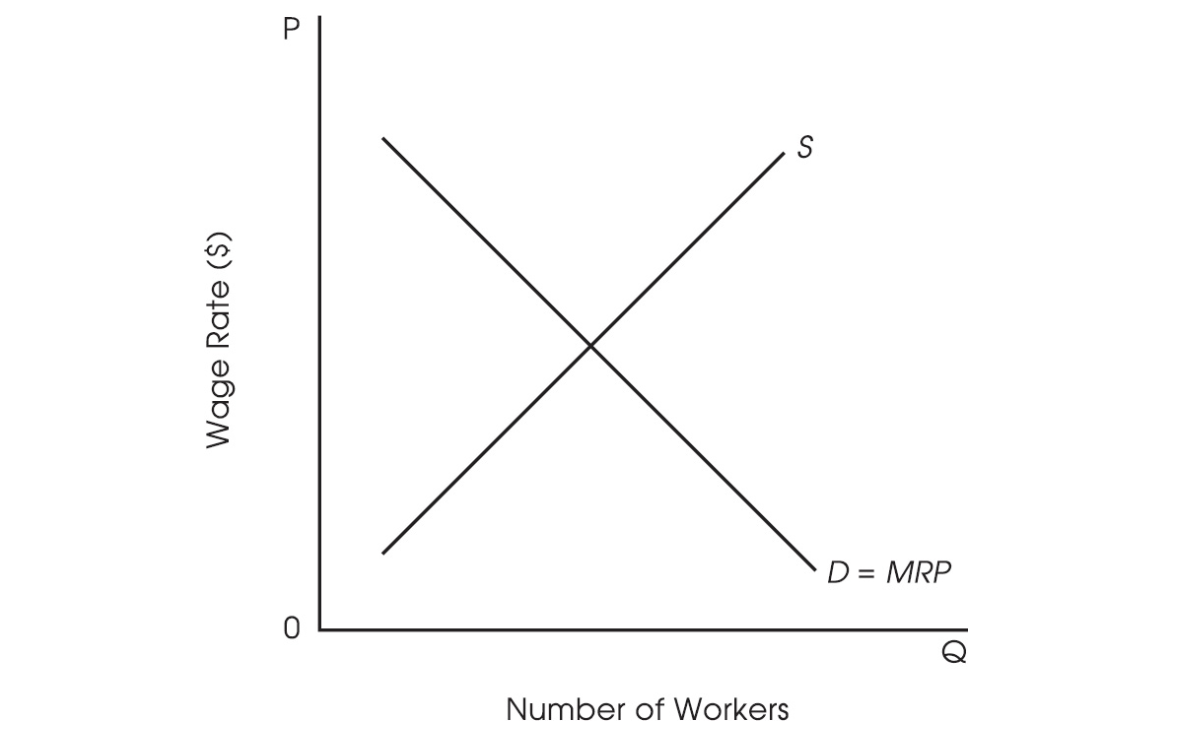
11. Which of the following will happen when a new computerized system for a firm increases the marginal productivity of its workers?
(A) The marginal revenue product curve will shift to the left, which will cause the wage rate to decrease.
(B) The supply curve will shift to the right, causing the wage rate to decrease.
(C) The marginal revenue product curve will shift to the right, causing the wage rate to increase.
(D) The supply curve will shift to the left, causing the wage rate to increase.
(E) The marginal revenue product curve will shift to the right and the supply curve will shift to the left, leaving the wage rate unchanged.
12. Which of the following is true about an effective price floor?
(A) It is used to correct government policy.
(B) It is used when the equilibrium price is too high.
(C) It will be located above the equilibrium price.
(D) It will be located below the equilibrium price.
(E) It is when the stock market has closed at a new low.
13. Which of the following is true about an effective price ceiling?
(A) It is used to correct government policy.
(B) It is used when equilibrium prices are too low.
(C) It will be located above the equilibrium price.
(D) It will be located below the equilibrium price.
(E) It is when the stock market has closed at a new high.
14. Which of the following situations best exemplifies the concept of consumer surplus?
(A) It refers to a consumer who no longer has any outstanding debts.
(B) The federal government has taken in more revenue than it has paid out in expenditures.
(C) A consumer does not buy a pizza as it costs more than the highest price she is willing to pay.
(D) A consumer pays less for a pizza than the highest price she is willing to pay.
(E) A consumer buys a pizza for the exact highest price she is willing to pay.

15. Given the data in the table above and knowing that workers are paid $1,250 every two weeks and that widgets are sold to retailers at $50, how many workers would be hired?
(A) Two
(B) Three
(C) Four
(D) Five
(E) Six
Questions 16–19 are based on the monopoly graph below.
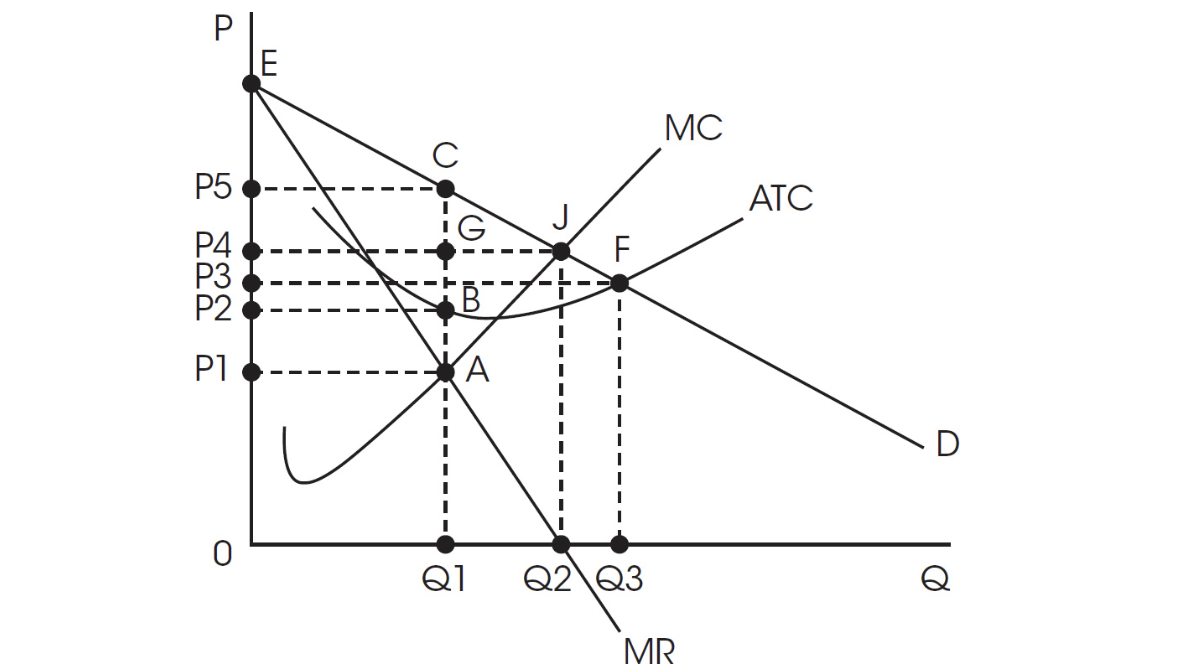
16. An unregulated, profit-maximizing monopoly will produce at which quantity and price?
(A) Q1, P5
(B) Q1, P2
(C) Q1, P1
(D) Q2, P4
(E) Q3, P3
17. If this monopoly were regulated as a natural monopoly and ordered to produce at the socially optimal quantity, what would be the quantity and price?
(A) Q1, P5
(B) Q1, P2
(C) Q1, P1
(D) Q2, P4
(E) Q3, P3
18. What is the area of economic profit if this was an unregulated, profit-maximizing monopoly?
(A) 0, P2, B, Q1
(B) 0, P5, C, Q1
(C) P2, P5, C, B
(D) P1, P5, C, A
(E) 0, P1, A, Q1
19. If a lump-sum tax were now placed on this unregulated monopoly, what would happen to the new profit-maximizing quantity and price?
(A) Price and quantity would remain unchanged
(B) Price would increase and quantity would decrease
(C) Price would decrease and quantity would decrease
(D) Price would decrease and quantity would increase
(E) Price would increase and quantity would increase
Questions 20–22 are based on the perfectly competitive market depicted below.
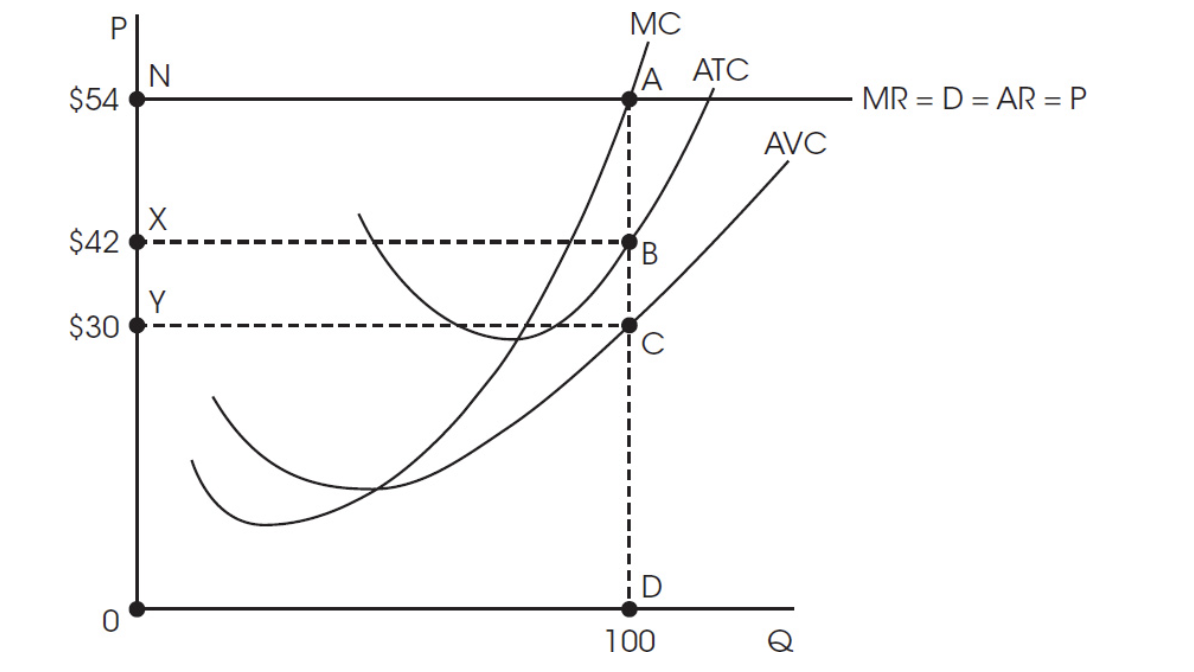
20. At a market price of $54, the area of profits or losses is
(A) 0, Y, C, D
(B) 0, X, B, C
(C) X, N, A, B
(D) Y, X, B, C
(E) 0, N, A, D
21. Based on the graph, what is the total fixed cost at the profit-maximizing quantity?
(A) $54
(B) $1,200
(C) $2,400
(D) $3,000
(E) $5,400
22. What will happen to the number of firms in the long run in this industry based on the profit conditions in this perfectly competitive firm?
(A) The number of firms will increase as the existence of economic profits attracts more firms.
(B) The number of firms will decrease as the existence of economic profits attracts fewer firms.
(C) The number of firms will decrease as the existence of economic losses causes firms to leave
(D) The number of firms will increase as the existence of economic losses attracts more firms.
(E) The number of firms will remain unchanged as all the profits in the industry are gone.
23. If a 10% increase in the price of good A leads to a 20% decrease in the quantity demanded of good B, then
(A) the cross-price elasticity is 0.5 and the goods are complements.
(B) the cross-price elasticity is -2 and the goods are complements.
(C) the cross-price elasticity is 2 and the goods are complements.
(D) the income elasticity is 2 and the goods are inferior.
(E) the income elasticity is 0.5 and the goods are normal.
24. If the government announces that the drinking of red grape juice reduces the risk of heart attacks, which of the following will be correct in terms of changes in supply, demand, and the price of red grape juice?

Questions 25–28 are based on the figure below.
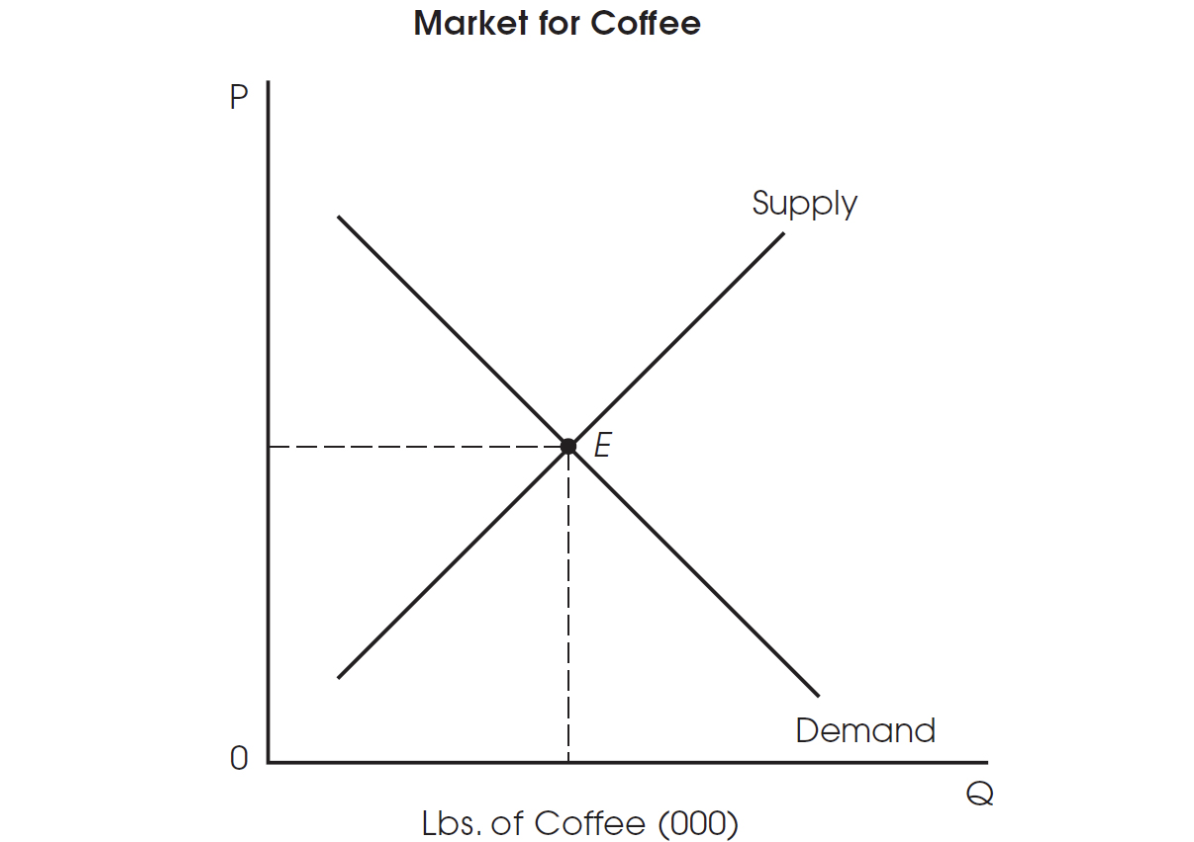
25. If the demand for coffee increases and at the same time increases in productivity lower production costs, what would happen to the new price and quantity?

26. If the government provides a subsidy to the producers of coffee, which of the following will occur?
(A) A shift to the left of the supply curve
(B) A shift to the left of the demand curve
(C) A move along the supply curve to the right
(D) A shift to the right of the demand curve
(E) A shift to the right of the supply curve
27. If the producers of coffee have to pay an increase in wages and fringe benefits to their workers, which of the following is correct?
(A) A shift to the left of the supply curve
(B) A shift to the left of the demand curve
(C) A move along the supply curve to the right
(D) A shift to the right of the demand curve
(E) A shift to the right of the supply curve
28. If the price of coffee increases (a normal good), which of the following is most likely to happen?
(A) An increase in the quantity of coffee consumers want to purchase
(B) No change in the quantity of coffee consumers want to purchase
(C) A decrease in the quantity of coffee consumers want to purchase
(D) An increase (shift)in the demand for coffee
(E) A decrease (shift)in the demand for coffee
Use the following graph for Question 29.
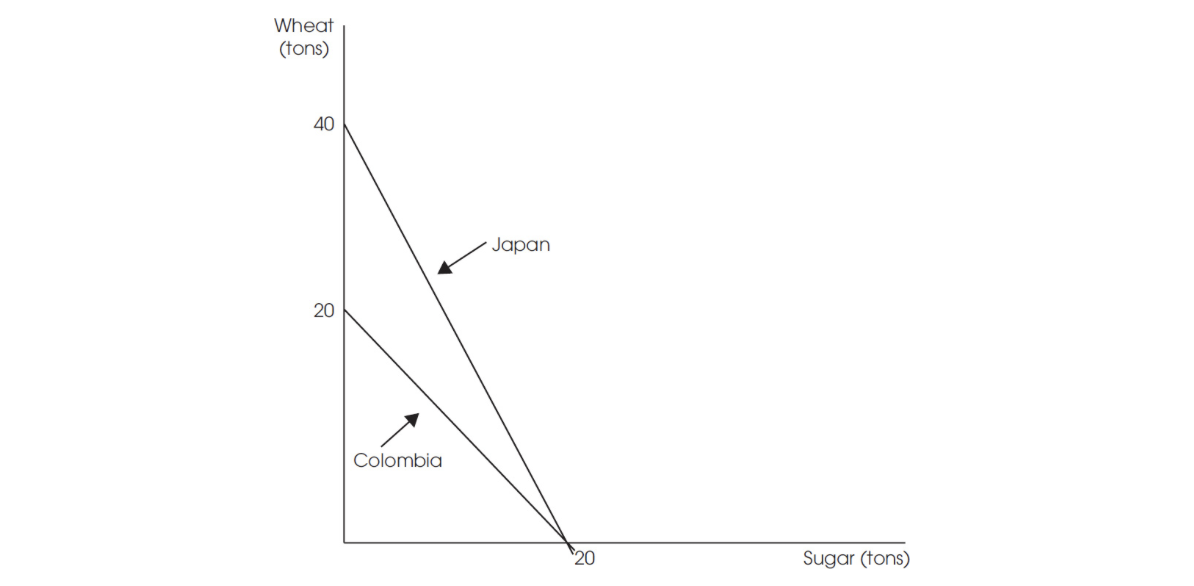
29. The production possibilities graph shows how much each country can produce in a year. According to the graph, which of the following is true?
(A) Colombia has an absolute advantage in the production of wheat.
(B) Japan has a comparative advantage in the production of sugar.
(C) Colombia has a comparative advantage in the production of wheat.
(D) Japan cannot benefit from trade with Colombia.
(E) Japan has a comparative advantage in the production of wheat.
Questions 30–31 are based on the figure below.
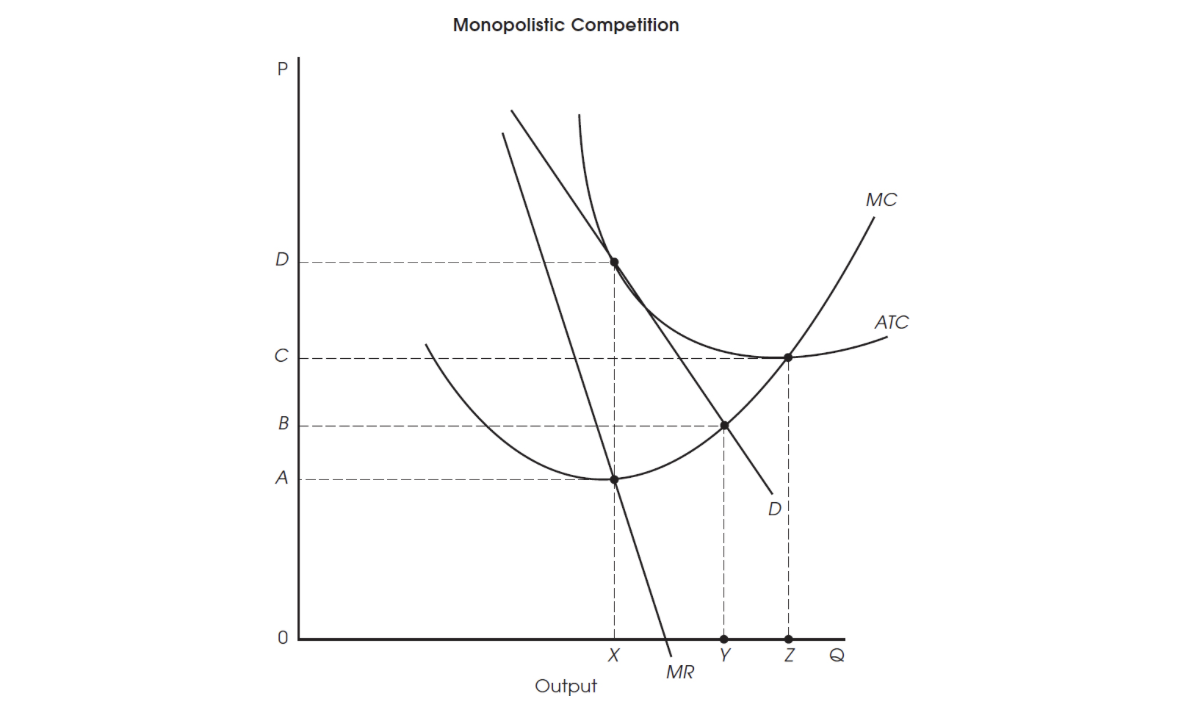
30. For this firm operating under monopolistic competition, which of the following is the profit- maximizing output and price?
(A) OX output and OA price
(B) OX output and OD price
(C) OX output and OB price
(D) OZ output and OC price
(E) OZ output and OA price
31. At the profit-maximizing output, which of the following is correct?
(A) Economic profits are zero, and the firm is operating efficiently.
(B) Economic profits are above normal, and output is greater than under perfect competition.
(C) Economic losses are present.
(D) Price is less than marginal cost.
(E) Economic profits are zero, and the firm is operating inefficiently.
32. Which of the following best exemplifies economies of scale?
(A) As a firm’s output decreases, long-run average total cost decreases.
(B) As a firm’s output increases, long-run average total cost increases.
(C) As a firm’s output increases, long-run average total cost decreases.
(D) As a firm’s output increases, long-run average total cost remains constant.
(E) As a firm becomes larger, it becomes less productive.
33. Which of the following is correct?
(A) In the long run, all inputs are variable.
(B) In the short run, all inputs are variable.
(C) In the long run, supply is not able to adjust fully to changes in demand.
(D) In the short run, supply is able to adjust fully to changes in demand.
(E) A short run is any distance less than one mile.
34. If a firm decreases its prices by 15 percent and the quantity demanded increases by 30 percent, which of the following is correct?
(A) The price elasticity of demand is unit elastic.
(B) The price elasticity of demand is perfectly elastic.
(C) The price elasticity of demand is relatively elastic.
(D) The numerical coefficient of elasticity is equal to one.
(E) The numerical coefficient of elasticity is less than one.
35. At its current level of output, a firm uses two inputs in the production process, labor and robots. Robots produce an output of 1,000 units a day and cost $500, and labor produces 200 units a day and costs $100. In order to lower total production costs, how should the firm change its use of labor and robots?
(A) Increase both amounts of labor and robots.
(B) Use more robots and less labor.
(C) Use more labor and fewer robots.
(D) Use less labor and fewer robots.
(E) Maintain the current level of robots and labor.
36. When marginal cost equals price in a perfectly competitive product market in long-run equilibrium, which of the following is NOT true?
(A) There is allocative efficiency as price = marginal cost.
(B) There is productive efficiency as price = minimum average total cost.
(C) The perfectly competitive firm is earning economic profits.
(D) The market is producing the amount of goods desired by society.
(E) The firm is earning a normal profit.
37. Which of the following is a correct statement?
(A) Average total cost equals marginal cost plus average fixed costs.
(B) Average total cost equals marginal costs plus average variable costs.
(C) Average total cost equals average fixed costs plus average variable costs.
(D) Total fixed costs vary with output.
(E) Total fixed costs equal total variable costs at zero output.
38. Which of the following describes a monopolistically competitive market?
(A) A small number of firms with high barriers to entry and exit
(B) A large number of firms with high barriers to entry and exit
(C) A small number of firms and allocative efficiency
(D) It produces products with no close substitutes
(E) Low barriers to entry and exit and excess capacity
Questions 39–41 are based on this monopoly graph.
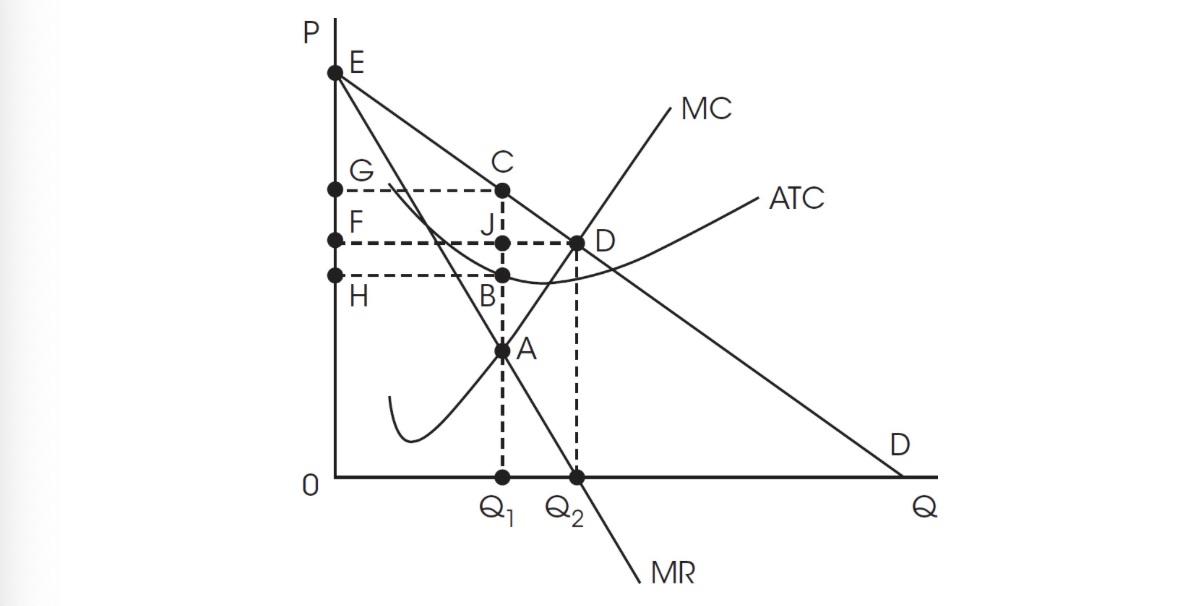
39. If this firm was producing at the socially optimal quantity, what area would be the consumer surplus?
(A) ECG
(B) CDA
(C) EDF
(D) GCBH
(E) GCJF
40. The deadweight loss as the result of the monopoly producing at the profit-maximizing quantity is the area of
(A) ECG
(B) CDA
(C) EDF
(D) GCBH
(E) GCJF
41. The consumer surplus of the monopoly producing at the profit-maximizing quantity is
(A) ECG
(B) CDA
(C) EDF
(D) GCBH
(E) GCJF
Use the following graph for Questions 42, 43, and 44.
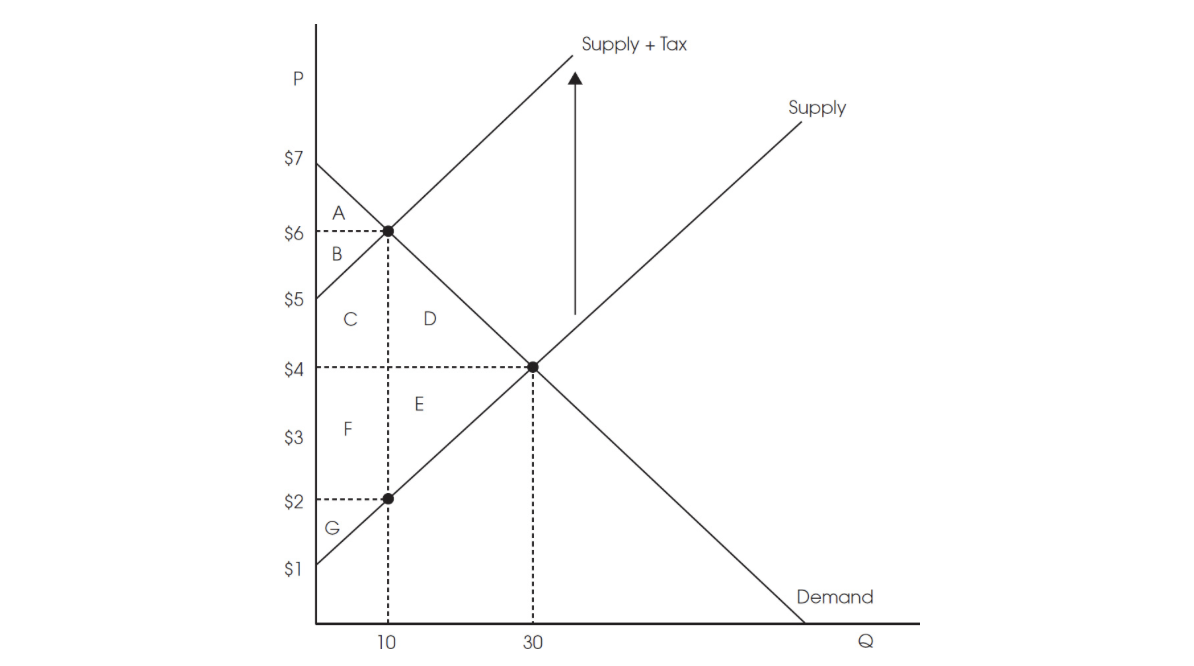 42. The market shown in the graph has had a per-unit tax placed on its production. What are the after-tax consumer and producer surpluses?
42. The market shown in the graph has had a per-unit tax placed on its production. What are the after-tax consumer and producer surpluses?

43. The market shown in the graph has had a per-unit tax placed on its production. What is the tax incidence, or burden of the tax paid by consumers and producers?

44.The market shown on the graph has had a per-unit tax placed on its production. What is the after-tax price paid by consumers and the after-tax price received by producers?

45. If, for each additional unit of a variable input added, the increases in output become smaller, which of the following correctly identifies the concept?
(A) Diminishing marginal returns
(B) Diminishing marginal utility
(C) Increasing marginal utility
(D) Increasing marginal productivity
(E) Constant costs
46. Which of the following is correct about the demand for labor?
(A) The demand for labor is independent of the demand for other inputs or resources.
(B) The demand for labor is independent of the demand for the products produced by labor.
(C) The demand for labor is independent of the availability of other inputs or resources.
(D) The demand for labor is derived from the demand for the products produced by labor.
(E) The demand for labor is derived from the demand for labor unions.
47. If an increase in the price of good Y causes the quantity demanded of good X to increase, this means the two goods are
(A) complementary goods.
(B) substitute goods.
(C) inferior goods.
(D) normal goods.
(E) independent goods.
Use the following graph for Question 48.
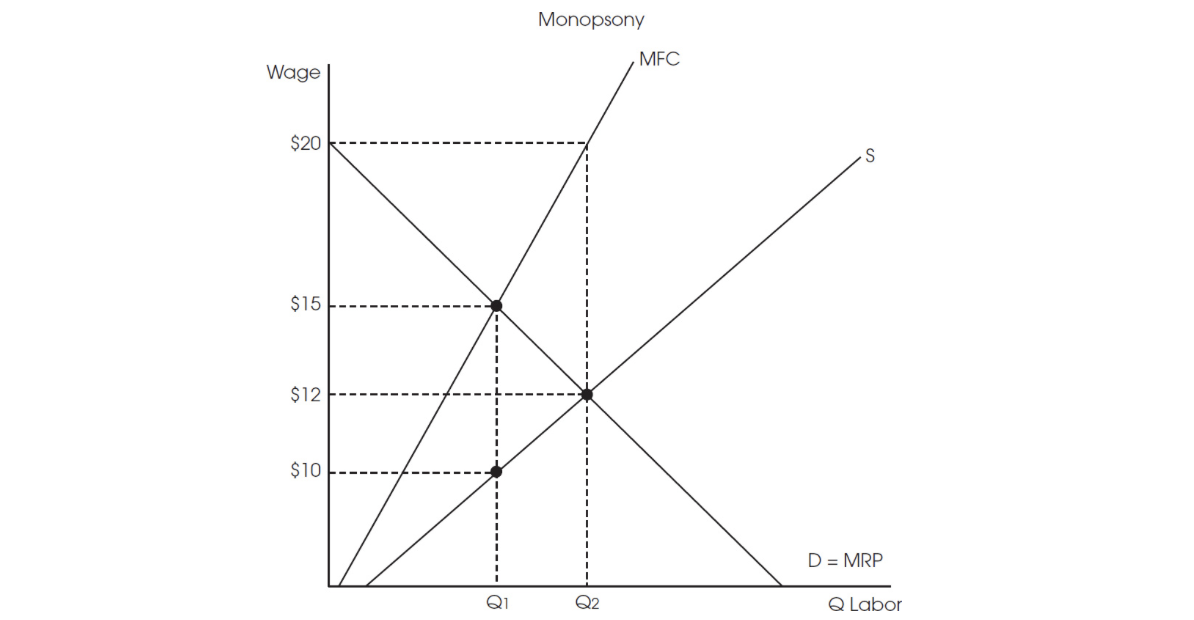
48.The graph shows a monopsony labor market. What is the profit-maximizing wage and quantity of workers hired by the monopsonist?

49. Under what conditions would a firm continue to hire labor in a perfectly competitive labor market?
(A) When the marginal revenue product is greater than the marginal factor cost
(B) When labor costs less than capital
(C) When the marginal revenue product is positive
(D) When the marginal factor cost is greater than the marginal revenue product
(E) When the average product is increasing
50. What law best describes a production possibilites curve that has a bowed out or concave shape from the origin?
(A) The law of productive efficiency
(B) The law of diminishing marginal utility
(C) The law of increasing opportunity cost
(D) The law of supply
(E) The law of demand
51. According to the table, what is the fixed cost, marginal cost, and average total cost of producing the 4th unit?
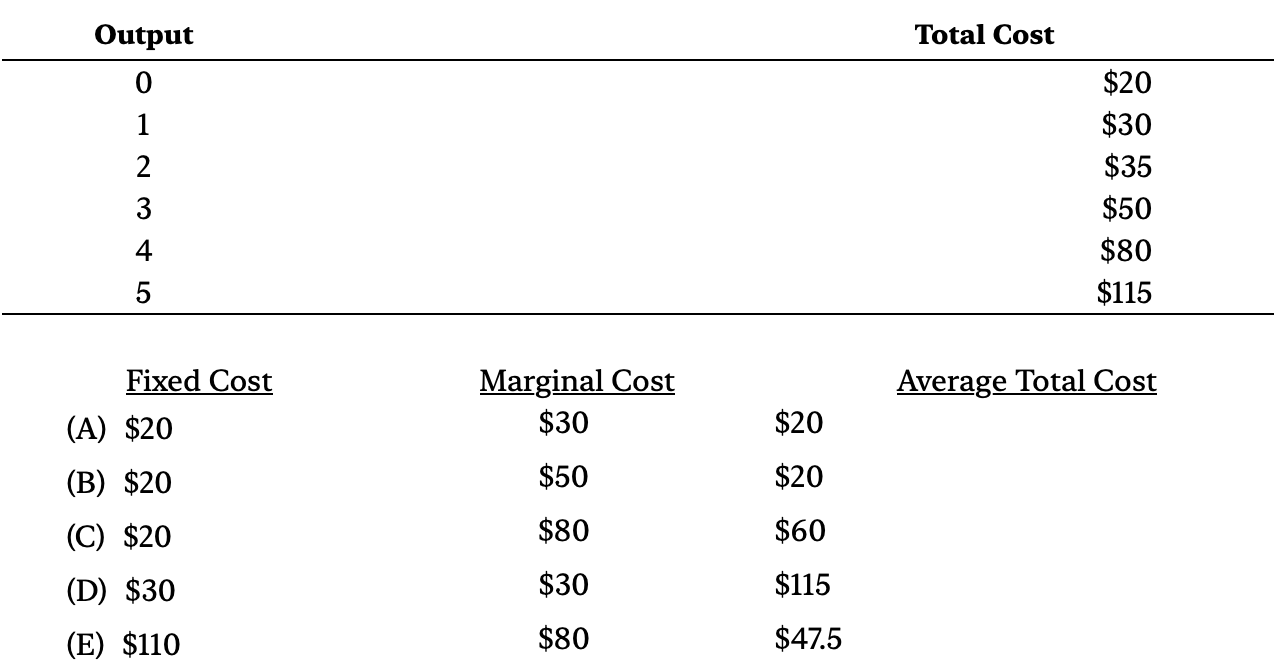
Use the following game theory matrix for Questions 52 and 53.

52. This game theory payoff matrix shows the possible profit for two firms deciding to price high or price low. Firm X will earn the profit to the left in each cell, and Firm Y’s profit is to the right in each cell. Which of the following statements is correct?
(A) Firm X’s dominant strategy is to price low.
(B) Firm X’s dominant strategy is to price high.
(C) Firm Y’s dominant strategy is to price low.
(D) Firm Y’s dominant strategy is to price high.
(E) Neither firm has a dominant strategy.
53. This game theory payoff matrix shows the possible profit for two firms deciding to price high or price low. Firm X will earn the profit to the left in each cell, and Firm Y’s profit is to the right in each cell. Assume each firm knows all the information in the payoff matrix. All of the following statements are correct EXCEPT
(A) if the two firms collude, Firm X will price high and Firm Y will price high.
(B) if Firm X prices low, then Firm Y will price low.
(C) Firm Y does not have a dominant strategy.
(D) the game will reach a Nash equilibrium with both pricing high.
(E) if Firm Y prices high, Firm X will price low.
54. Assume Celine’s Crab Shack earned an accounting profit of $20,000 this year. However, the owner and head chef, Celine, is also a talented artist who could have earned $30,000 painting and $2,000 in interest from the money she invested in her restaurant. Based on this information, which of the following statements is correct about Celine?
(A) She has incurred an economic loss as a chef.
(B) She has gained economic profits as a chef.
(C) She has a negative accounting profit as a chef.
(D) She is earning a normal profit as a chef.
(E) Her explicit costs are $12,000 as a chef.
55. For a profit-maximizing, nonprice-discriminating monopolist, marginal revenue is
(A) equal to price.
(B) negative when the firm is maximizing profit.
(C) more than the price.
(D) a perfect elastic curve.
(E) less than the price.
56. Assume that people like mustard on their hot dogs. Due to increases in the cost of production, the supply of hot dogs decreases. How will this affect the market for mustard?
(A) The demand for mustard will increase as hot dogs and mustard are complements.
(B) The quantity demanded of mustard will increase as hot dogs and mustard are complements.
(C) The demand for mustard will go down as hot dogs and mustard are complements.
(D) The supply of mustard will increase to offset the hot dog market.
(E) The demand and supply of mustard will remain unchanged.
Use this graph for Question 57.
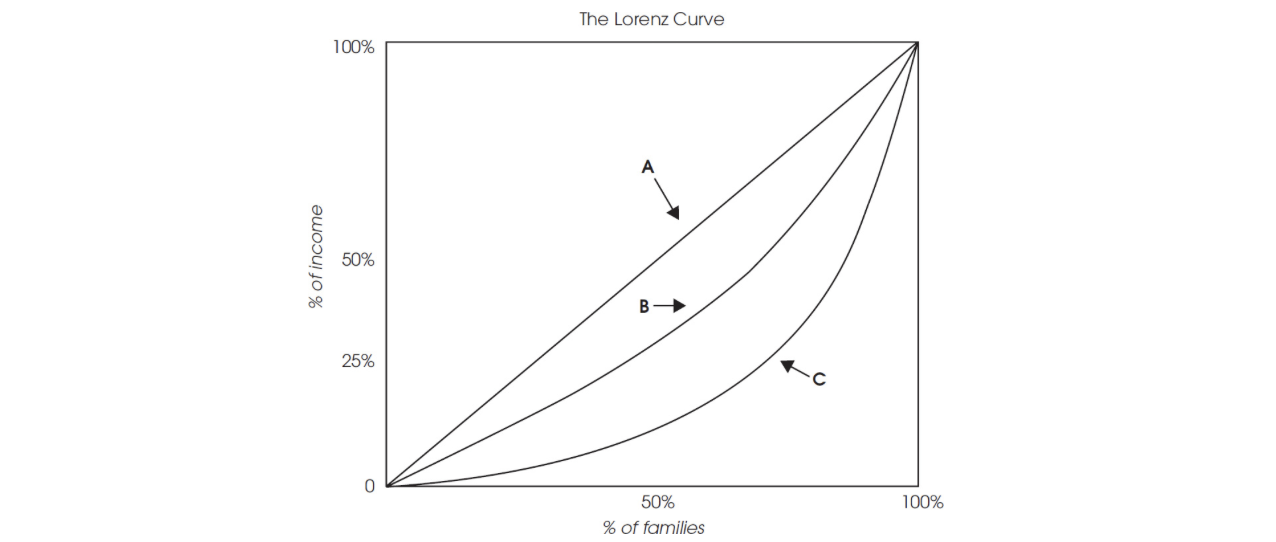
57. On the Lorenz curve, all of the following are true except
(A) line A shows more income inequality than line B.
(B) line A shows perfect income equality.
(C) line B shows less income inequality than line C.
(D) line C shows greater income inequality than line A.
(E) on line A, 50% of families earn 50% of the total income.
58. If a government passes an effective minimum wage law, in which of the following situations will the change in employment be the smallest?
(A) If labor demand is relatively elastic
(B) If labor demand is unit elastic
(C) If labor demand is relatively inelastic
(D) If labor demand is perfectly elastic
(E) If labor supply is relatively elastic
59. Assume the government imposes a 20% excise tax on all food sold in a country. Which of the following is true?
(A) This is a proportional tax.
(B) This is a regressive tax.
(C) This is a progressive tax.
(D) The quantity demanded for food will not change, as it is perfectly inelastic.
(E) There will be no additional tax revenue from this tax.
Use the following table to answer Question 60.

60. Assume Joe has only $45 to spend on entertainment. What combination of movies, which cost $10 per movie, and visits to the trampoline park, which cost $5 per visit, would maximize his utility?
(A) Going to the movies and trampoline park 2 times each
(B) Going to the movies and trampoline park 3 times each
(C) Going to the movies 2 times and the trampoline park 3 times
(D) Going to the movies 3 times and the trampoline park 5 times
(E) Going to the movies 4 times and the trampoline park 5 times
Section II—Free-Response Questions
1. Farmer Fred produces corn in a perfectly competitive market. Farmer Fred is earning economic profits.
(a) Draw correctly labeled, side-by-side graphs of both the market for corn and for Farmer Fred, showing each of the following:
(i) The equilibrium price and quantity in the corn market labeled PM1 and QM1.
(ii) The equilibrium price and quantity for Farmer Fred labeled PF1 and QF1.
(iii) Farmer Fred’s economic profit shaded in.
(b) As Farmer Fred is earning economic profits, what will happen in the market for corn as the economy adjusts to long-run equilibrium? In two newly drawn, side-by-side graphs of the corn market and Farmer Fred, show the following with correct labels:
(i)The initial equilibrium price and quantity in the corn market, PM1 and QM1.
(ii)The initial equilibrium price and quantity showing short-run economic profits for Farmer Fred, PF1 and QF1.
(iii)The new long-run equilibrium price and quantity in the corn market labeled PM2 and QM2.
(iv)The new long-run equilibrium price and quantity in the corn market for Farmer Fred labeled PF2 and QF2.
(c)At the new long-run equilibrium, is Farmer Fred earning an economic loss, or a normal profit?
(d)Now assume that in the corn market, the price of corn has decreased 20% while the quantity demanded at that price has increased 40%. Is the price elasticity of demand unit elastic, relatively elastic, perfectly elastic, relatively inelastic, or perfectly inelastic? Explain.
2. A firm has a patent that makes it the only producer in the market. The firm is currently earning economic profits in long-run equilibrium.
(a) Draw a correctly labeled graph with each of the following:
(i) The profit-maximizing quantity and price produced by the firm, labeled Qm and Pm.
(ii) The area of economic profit clearly shaded and labeled.
(iii) The area of deadweight loss clearly shaded and labeled.
(b) Now assume that the firm is producing at the socially optimal quantity. Label this quantity Qs on the same graph from 2a.
(c) As a profit-maximizing monopolist, what area of the demand curve will the monopolist operate: where demand is elastic, inelastic, or unit elastic?
(d) Now assume the monopoly is producing at the quantity where total revenue is maximized and then the firm produces increases production beyond that amount. Will marginal revenue be negative, positive, or zero? Explain.
3. After an outbreak of the flu, a public relations campaign by the government is encouraging more people to get flu shots, arguing that it produces a positive consumption externality.
(a) Draw a correctly labeled graph of this positive consumption externality, showing each of the following:
(i) The equilibrium market price and quantity, labeled PM and QM.
(ii) The socially optimal equilibrium price and quantity, labeled PS and QS.
(iii) The area of deadweight loss, shaded in.
(b) At the market quantity, is the marginal social benefit greater than, less than, or equal to the marginal private benefit?
(c) What type of action would you recommend to bring production to the socially optimal quantity? Explain.




